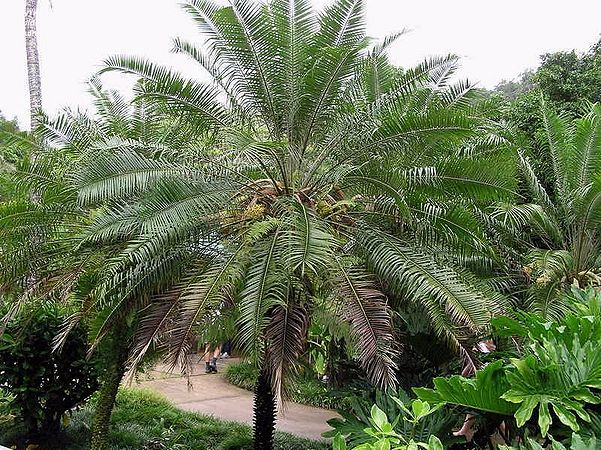Phoenix roebelenii
| Phoenix (FEH-niks) roebelenii (roh-behl-lehn-EE-ee) | ||||||||
|---|---|---|---|---|---|---|---|---|
 Phoenix_roebellenii_BHS.JPG | ||||||||
| Scientific Classification | ||||||||
| ||||||||
| Synonyms | ||||||||
|
| ||||||||
| Native Continent | ||||||||
|
| ||||||||
| Morphology | ||||||||
| ||||||||
| Culture | ||||||||
|
| ||||||||
| Survivability index | ||||||||
|
| ||||||||
| Common names | ||||||||
|
| ||||||||
Contents
Habitat and Distribution
China South-Central, Laos, and Vietnam. Northern Laos (Nam Ou valley), Vietnam (Upper Black R. region near Lai-Chau), and southern China (Xisuangbanna region of Yunnan), most notably along the banks of the R. Mekong. Closely associated with riverside or cliff habitats where it grows as a rheophyte. The rheophytic habit is rare within the palm family (Dransfield 1992). The clustering habit of R roebelenii may help it to survive flooding. (S.C. Barrow. 1998)/Palmweb.
Description
Clustering palm (often solitary in cultivation), forming clumps with stemless plants suckering at base of taller stems. Stem 1 - 2 m (rarely 3 m) high, without sheaths to 10 cm in diam., erect or twisted, pale, becoming smooth with age, marked with diamond-shaped persistent leaf bases each with a central bump of remnant vascular tissue; stem base developed with a root boss; roots occasionally emerging from stem above ground level. Leaves arching, 1 - 1.5 (2) m long; pseudopetiole to about 50 cm long; leaf sheath reddish-brown, fibrous; acanthophylls arranged singly or paired, about 12 on each side of rachis, orange-green, to 8 cm long; leaflets regularly arranged, opposite, about 25 - 50 on each side of rachis, linear, concolorous, deep green, often flaccid, to 40 x 1.2 cm; lamina with discontinuous white scurfy ramenta along abaxial veins and midrib, almost totally covering abaxial surface of unexpanded (sword) leaves. Staminate inflorescences pendulous; prophyll coriaceous, two-keeled, splitting once abaxially between keels, about 30- 60 cm long; peduncle to 30 cm long; rachillae 7- 20 cm long. Staminate flowers with calyx a three-pointed cupule, 1.2 mm high, yellow- white; petals pale yellow-white with acuminate apices and with jagged margins, 7 - 8 x 2 - 2.5 mm; anthers 3.5 - 4 mm long. Pistillate inflorescences erect, arching as fruits ripen, up to 35 cm long; prophyll coriaceous, two-keeled, to 35 cm long x about 5 cm wide, splitting once adaxially between keels to reveal inflorescence; peduncle green, to about 30 x 3 cm; rachillae with bulbous bases, orange-green, occasionally branched to one order, subtended by papery bracts (about 4 cm long). Pistillate flowers pale green, arranged in distal three quarters of rachilla, subtended by papery bracts to 5 mm long; calyx a three-pointed cupule, thickened and ridged up to apices, striate, 2 - 2.5 mm high; petals 3.5 x 4 mm with acute apices; generally only one carpel reaching maturity. Fruits obovoid, with persistent perianth, maturing from dark green to purplish brown, 13 - 18 x 6 - 7 mm; stigmatic remains apical, 1 mm long, orange- brown, often recurved. Seed narrowly elongate, terete, with rounded apices, 7 - 3 mm; embryo lateral opposite raphe; endosperm homogeneous. (S.C. Barrow. 1998)/Palmweb. Editing by edric.
Culture
Very adaptable to most soils (use light, fast draining soils in containers). Fertilize 3 times a year. Light: Bright sun to partial shade. Moisture: Needs adequate moisture for best look. Has some drought tolerance when mature. Hardiness: USDA Zones 9-11 May be cold damaged at temperatures below 30ºF (-1ºC). Propagation: By seeds (they take about 3 months to germinate).
Comments and Curiosities
| read more |
|---|
|
Conservation: A naturally restricted distribution, habitat loss and a horticultural trade in wild-collected plants may mean that the wild populations of P. roebelenii merit 'vulnerable' status, but further studies are needed. Demand for P. roebelenii as an ornamental is mostly met through seeds and offshoots from cultivated plants. However, Barrow (1994) suggested that collection of mature palms from the wild poses an increasing threat. (S.C. Barrow. 1998) Uses: Since its introduction to Europe, P. roebelenii has become a popular and widely cultivated ornamental palm and is now found in private and botanical gardens around the world. (S.C. Barrow. 1998)/Palmweb. "This is one of the most commonly grown palms in malls and public plantings in Southern California. It is hardy, despite its origins in tropical Asia, and is one of the more 'user friendly' Phoenix palms, having soft, feathery leaves. However, it still has some sharp, 1-2" spines at the base of each leaf, so careful when pruning. It is actually, for a palm, one of the faster growing palms in Southern California. Though it is the pigmy of the Phoenix, it can grow up to 15' tall (may take 20-30 years to get that tall, though). It is usually not clustering, but sold in clumps, making it look that way." (Geoff Stein) |
External Links
References
Phonetic spelling of Latin names by edric.
Special thanks to Geoff Stein, (Palmbob) for his hundreds of photos.
Special thanks to Palmweb.org, Dr. John Dransfield, Dr. Bill Baker & team, for their volumes of information and photos.
Glossary of Palm Terms; Based on the glossary in Dransfield, J., N.W. Uhl, C.B. Asmussen-Lange, W.J. Baker, M.M. Harley & C.E. Lewis. 2008. Genera Palmarum - Evolution and Classification of the Palms. Royal Botanic Gardens, Kew. All images copyright of the artists and photographers (see images for credits).
S.C. Barrow, A Monograph of Phoenix L. (Palmae: Coryphoideae). 1998. A Monograph of Phoenix L. (Palmae: Coryphoideae). Kew Bulletin, Vol. 53, No. 3 (1998), pp. 513-575.
- IMAGE GALLERY
Many Special Thanks to Ed Vaile for his long hours of tireless editing and numerous contributions.










































